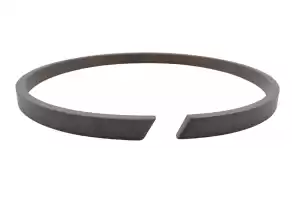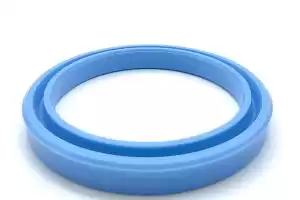PTFE seals are exceptional sealing solutions with a wide range of applications. They are the best sealing materials for different industrial applications due to their outstanding durability and chemical resistance.
This blog covers everything you need to know about PTFE seals. Let’s take a look at and help you to correctly use and select suitable PTFE seals to improve your economic benefits.
This blog covers everything you need to know about PTFE seals. Let’s take a look at and help you to correctly use and select suitable PTFE seals to improve your economic benefits.
What is a PTFE Seal?
PTFE seal meaning is mainly made of Polytetrafluoroethylene material of seal .Their chemical structure takes in carbon and fluorine atoms in a bonded form. Besides polytetrafluoroethylene, these seals may include other materials such as carbon, glass fiber, copper powder, etc. You can use these seals to prevent leakage under extreme conditions.


Types of PTFE Seals
PTFE seals come in a variety of types. Each type of seal has its unique applications, depending on the specific properties. We briefly discuss a few types below:
1.PTFE O-Rings
The PTFE O-rings are circular seals usually making them useful for automotive, aerospace, and hydraulic systems.
2.PTFE Backup Rings
Sometimes PTFE O-rings are not enough to keep the tight seals. This is where PTFE backup rings come in handy. When used along O-rings, they prevent deformation or extrusion even under high pressure. The common applications of these rings are in rotary shaft seals, pneumatic and hydraulic systems.
3.PTFE Gaskets
The PTFE gaskets are the most suitable option for sealing 2 joining surfaces. These gaskets usually come in shapes like flat and spiral wound. Low friction, higher chemical resistance, and thermal stability are the prominent characteristics of these gaskets making them suitable for use in industries like automotive, food processing, and chemical processing.
4.PTFE Lip Seals
They are commonly used seals to prevent leakage the reciprocating or rotating motion in the cylinder. That’s the reason they are known as PTFE rotary shaft seals. One of the most common applications of these seals is in hydraulic system, pumps, and so on.
5.PTFE V-Rings
Sometimes rotary equipment requires an effective sealing barrier. PTFE v-rings come in handy in these situations. They are best for sealing applications on various shafts, pumps, and gearboxes.
6.Spring Energized PTFE Seals
Irregular surfaces are a big issue when using seals. But spring-energized PTFE seals have overcome this hurdle. These seals have helical spring that helps maintain solid contact with the surfaces due to radial energization.
Applications of PTFE Seals
1.Construction Machinery
PTFE seals can be used in Excavators, loaders, etc., due to their extreme wear resistance and temperature resistance.
2. Aerospace
In addition, their common applications in the automotive and aerospace industries include usage in pumps, hydraulic systems, engines, brakes, etc. They are perfect for quick disconnects, gearboxes, APUs, landing gear, and fuel systems.
3. Petroleum Industry
Most machinery used in the oil and gas industry has PTFE seal applications. They are used in downhole tools, HPHT environments, surface drilling equipment, and LNG pipe equipment. PTFE seals are also commonly used for subsea and deepwater equipment.
4. Medicinal Applications
You already know that PTFE seals are biocompatible, this quality makes them ideal for use in medical applications. That is why they are used in hematology analyzers, autoclaves, surgical tools, and oxygen concentrators.
Advantages of PTFE Seals
You can get various advantages due to the exceptional properties of PTFE seals.
1. Extreme compatibility
You can use PTFE seals under chemical, acid, and solvent exposure due to their extreme chemical resistance. That makes them indispensable in industries like pharmaceuticals, chemical processing, and semiconductor manufacturing.
2. Low Friction
The low friction properties of PTFE seals make them a perfect choice for frictionless performance. These high-quality seals have reduced wear and tear and improved efficiency.
3. High-Temperature Resistance
PTFE seals can bear extreme temperatures without significant deterioration. So, you can easily use these seals in operations like aerospace, automotive, oil and gas, food processing, and industrial machinery.
4. Excellent Durability
The extra hardy nature of PFTE seals makes them durable and sturdy. It shows their resilience to the different environmental stresses.
Production Processes of PTFE Seals
Manufacturing PTFE seals is quite complex and involves several steps, such as the selection of raw materials, molding, curing, and the final product. Here is a detailed process of manufacturing PTFE seals;
1. Preparing Raw Material
In this step, high-quality PTFE are selected as the raw materials for producing the desired PTFE seals. These resins are then transformed into a granular or powdered form which helps in the processing of seals. Selecting this form impacts their final form and physical properties.
2.Pressing into TPFE tubing
There are various molding methods to shape the PTFE seals. Among those, the popular molding methods include molding and extrusion. As for the molding process, this step involves pouring the raw material into the mold cavity. After that, you get the PTFE tube by applying high pressure on the mold with the help of a machine.
3. Curing & Frittage
Once you get the desired shape of the seal, the next process is passing it through heat treatment to improve the mechanical and resistance properties of the seal. In this way, you can ensure the optimal performance of your seals under extreme conditions.
4.CNC Machining Turning
The last step of PTFE seal production includes finishing into desired dimensions through CNC machining and surface finishing.This production process is more precise than other production methods In addition, various tests upheld involve leak and pressure testing, and dimensional analysis to ensure the high standard of the seals.

PTFE Seals Installation
Following are the guide you step by step:
1.Check the Seal
Start by examining the physical state of PTFE seals. Ensure that the seal is intact and free of any damage. This inspection ensures that you use only qualified seals that fit the installation. Besides that, you should avoid seals that are physically deformed or have the incorrect size for the application.
2. Clean Surface
This is one of the most important factors in determining the perfect installation of the PTFE seals. Cleaning the mating metal surface and seals is necessary for good contact between them. If any debris remains on either surface, it can affect the sealing performance.
3. Lubricate Properly
Lubrication plays an important role in sealing performance in a number of ways. It ensures that seals fit easily in the grooves. Furthermore, lubricating PTFE seals helps them easily install and prevents early wearing.
4. Installation
Avoid PTFE seals forceful installation with hands. Simply use the right force to push the seal into the groove. You also can use the PTFE seal installation tool to help installation in easy. For example, thin-walled installation tools are handy for PTFE seal installation.
5. Final Inspection
This is the last but not least important step in the PTFE installation. Check for the gaps between the grooves and the seal. You should inspect that the PTFE seal sits correctly between the metal mating parts.
PTFE Seals Design and Selection Considerations
While PTFE seal properties and exception resistance to almost everything are exemplary, there are still a few things to consider. Follow these metrics to select the right seal for your requirements.
1. Choose a Seal Type
You have already learned about the types of PTFE seals. Consider the properties and applications of each seal type and choose them wisely.
2. Suitable Material
PTFE seals come in pure PTFE and filled PTFE. You need to according to the actual working conditions, such as medium, operating temperature, pressure. Pure PTFE has universal application as it resists chemicals and high temperatures. However, filled PTFE-like spring-energized PTFE seals can fulfill certain higher performance requirements.
3. Design and Fit
There are a variety of PTFE seal designs like o-rings, v-rings, etc. These shapes are suitable for specific installations only. Besides that, they come in various sizes. So, choose the design and size that can fit well for the best sealing performance.
Conclusion
PTFE seals offer many advantages and withstand extreme conditions without much wear. Just ensure that you select the right type of PTFE seal for the application.
At the same time, you need to consider the price of PTFE seals. TYS is the earliest and most mature manufacturer In China of PTFE seals with high qulity competitive price. If you need PTFE seals, you can review the PTFE seals product in the following resources.
More Resources:
PTFE Seals Product
Teflon™ VS PTFE
PTFE Temperature Range
How to make PTFE gaskets?







